

Compact Muon Solenoid
LHC, CERN
| CMS-PAS-HIN-16-007 | ||
| D0 meson vn harmonics in PbPb collisions at 5.02 TeV | ||
| CMS Collaboration | ||
| September 2016 | ||
| Abstract: The Fourier coefficients v2 and v3, which reflect the azimuthal anisotropy of D0 meson, is measured with scalar-product method in PbPb collisions at √sNN= 5.02 TeV with CMS. The measurement is done in a wide pT range up to 40 GeV/c, for centrality classes 0-10%, 10-30% and 30-50%. It is the first measurement on D0 v3 and the uncertainties on D0 v2 are significantly improved compared with previous measurements. The measured D0 vn (n = 2, 3) is consistent with charged particle vn in central collisions, and begins to be lower than charged particles vn in pT range 1 to 6 GeV/c for more peripheral collisions. In high pT range, non-zero D0 v2 is also observed, which indicates the path length dependent energy loss of charm quark. | ||
|
Links:
CDS record (PDF) ;
inSPIRE record ;
CADI line (restricted) ;
These preliminary results are superseded in this paper, PRL 120 (2018) 202301. The superseded preliminary plots can be found here. |
||
| Figures & Tables | Summary | Additional Figures | References | CMS Publications |
|---|
| Figures | |

png pdf |
Figure 1:
Examples of simultaneous fit on mass spectrum and v2 (top) or v3 (bottom) as a function of invariant mass in selected pT intervals. |

png pdf |
Figure 1-a:
Example of simultaneous fit on mass spectrum and v2 as a function of invariant mass in selected pT intervals. |

png pdf |
Figure 1-b:
Example of simultaneous fit on mass spectrum and v2 as a function of invariant mass in selected pT intervals. |

png pdf |
Figure 1-c:
Example of simultaneous fit on mass spectrum and v3 as a function of invariant mass in selected pT intervals. |

png pdf |
Figure 1-d:
Example of simultaneous fit on mass spectrum and v3 as a function of invariant mass in selected pT intervals. |

png pdf |
Figure 2:
Prompt D0 fractions in raw D0 yield as function of pT for centrality classes 0-10% (left), 10-30% (middle) and 30-50% (right) with all analysis cuts (red circles) and without b0< 0.008 cm cut (blue squares). |

png pdf |
Figure 3:
Prompt D0 v2 for centrality 0-10% (left), 10-30% (middle) and 30-50% (right). Charged particle v2 [21] in the same centrality class is also plotted for comparison. |

png pdf |
Figure 4:
Prompt D0 v3 for centrality 0-10% (left), 10-30% (middle) and 30-50% (right). Charged particle v3 [21] in the same centrality class is also plotted for comparison. |
| Tables | |

png pdf |
Table 1:
Summary of systematic uncertainties for v2 and v3 for centrality class 30-50%. Absolute uncertainties are assigned. |
| Summary |
| In summary, azimuthal anisotropy v2 and v3 of D0 is measured with scalar-product method in PbPb collisions at √sNN= 5.02 TeV with CMS, which is the first measurement on v3 of D0. To extract v2 and v3 of prompt D0, the systematic uncertainties from non-prompt D0 are studied in a data driven method. Prompt D0 v2 is found to be positive in studied pT range 1 to 40 GeV/c, and prompt D0 v3 is also found to be positive in pT range around 1 to 8 GeV/c. The measured prompt D0 vn (n= 2, 3) is consistent with charged particle vn in central collisions, and is lower than vn of charged particles in pT range 1 to 6 GeV/c for more peripheral collisions. |
| Additional Figures | |

png pdf |
Additional Figure 1:
Mass spectrum fit in pT intervals 2-3 GeV/c (a) and 20-40 GeV/c (b) for centrality 0-10%. |
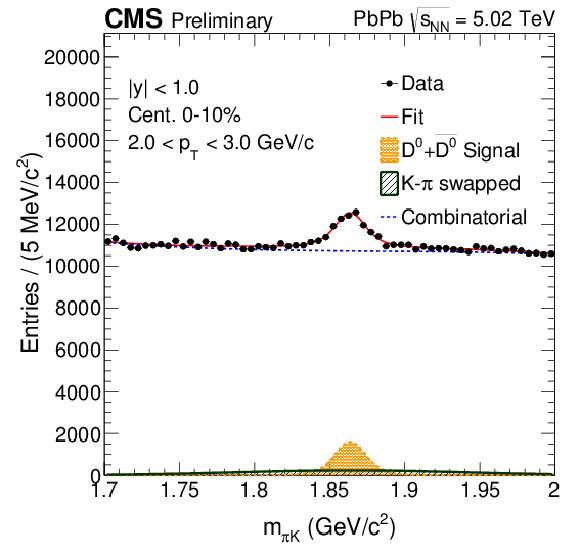
png pdf |
Additional Figure 1-a:
Mass spectrum fit in pT interval 2-3 GeV/c for centrality 0-10%. |
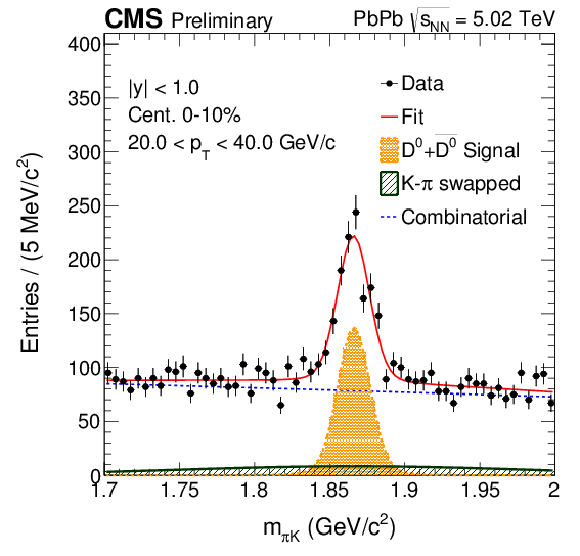
png pdf |
Additional Figure 1-b:
Mass spectrum fit in pT interval 20-40 GeV/c for centrality 0-10%. |

png pdf |
Additional Figure 2:
Mass spectrum fit in pT intervals 1-2 GeV/c (a), 2-3 GeV/c (b) and 20-40 GeV/c (c) for centrality 10-30%. |

png pdf |
Additional Figure 2-a:
Mass spectrum fit in pT interval 1-2 GeV/c for centrality 10-30%. |

png pdf |
Additional Figure 2-b:
Mass spectrum fit in pT interval 2-3 GeV/c for centrality 10-30%. |

png pdf |
Additional Figure 2-c:
Mass spectrum fit in pT interval 20-40 GeV/c for centrality 10-30%. |

png pdf |
Additional Figure 3:
Mass spectrum fit in pT intervals 1-2 GeV/c (a), 2-3 GeV/c (b) and 20-40 GeV/c (c) for centrality 30-50%. |

png pdf |
Additional Figure 3-a:
Mass spectrum fit in pT interval 1-2 GeV/c for centrality 30-50%. |

png pdf |
Additional Figure 3-b:
Mass spectrum fit in pT interval 2-3 GeV/c for centrality 30-50%. |

png pdf |
Additional Figure 3-c:
Mass spectrum fit in pT interval 20-40 GeV/c for centrality 30-50%. |

png pdf |
Additional Figure 4:
Example of template fit on impact parameter distributions to evaluate prompt D0 fraction in PbPb collisions in pT interval 5-6 GeV/c for centrality 10-30%. |

png pdf |
Additional Figure 5:
Example of d2N/(dpTdΔϕ) fit for vobs2 with Δϕ bins method in pT interval 5-6 GeV/c for centrality 10-30%. |

png pdf |
Additional Figure 6:
Prompt D0 fractions for centrality 0-10% (left), 10-30% (middle) and 30-50% (right) with all analysis cuts. |

png pdf |
Additional Figure 7:
Prompt D0 v2 for centrality 0-10% (left), 10-30% (middle) and 30-50% (right). |
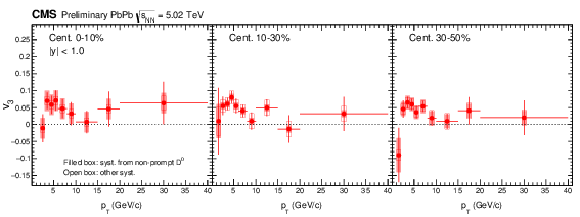
png pdf |
Additional Figure 8:
Prompt D0 v3 for centrality 0-10% (left), 10-30% (middle) and 30-50% (right). |

png pdf |
Additional Figure 9:
D0 v2 from SP method and Δϕ bins method for centrality 0-10% (left), 10-30% (middle) and 30-50% (right). |

png pdf |
Additional Figure 10:
D0 v3 from SP method and Δϕ bins method for centrality 0-10% (left), 10-30% (middle) and 30-50% (right). |

png pdf |
Additional Figure 11:
Prompt D0 v2 for centrality 0-10% (left), 10-30% (middle) and 30-50% (right). Calculations from theoretical models (PRC 94 014909 (2016), PLB 735 (2014) 445, JHEP 1602 (2016) 169 and PRD 91 074027 (2015)) are plotted for comparison. Charged particle v2 in the same centrality class is also plotted for comparison. |
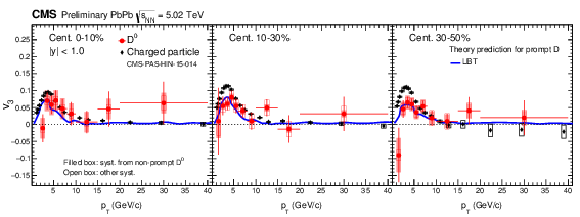
png pdf |
Additional Figure 12:
Prompt D0 v3 for centrality 0-10% (left), 10-30% (middle) and 30-50% (right). Calculations from LBT model (PRC 94 014909 (2016)) are plotted for comparison. Charged particle v3 in the same centrality class is also plotted for comparison. |

png pdf |
Additional Figure 13:
Prompt D0 v2 for centrality 0-10% (a), 10-30% (b) and 30-50% (c). Calculations from theoretical models (PRC 94 014909 (2016), PLB 735 (2014) 445, JHEP 1602 (2016) 169 and PRD 91 074027 (2015)) are plotted for comparison. Charged particle v2 in the same centrality class is also plotted for comparison. |

png pdf |
Additional Figure 13-a:
Prompt D0 v2 for centrality 0-10%. Calculations from theoretical models (PRC 94 014909 (2016), PLB 735 (2014) 445, JHEP 1602 (2016) 169 and PRD 91 074027 (2015)) are plotted for comparison. Charged particle v2 in the same centrality class is also plotted for comparison. |

png pdf |
Additional Figure 13-b:
Prompt D0 v2 for centrality 10-30%. Calculations from theoretical models (PRC 94 014909 (2016), PLB 735 (2014) 445, JHEP 1602 (2016) 169 and PRD 91 074027 (2015)) are plotted for comparison. Charged particle v2 in the same centrality class is also plotted for comparison. |
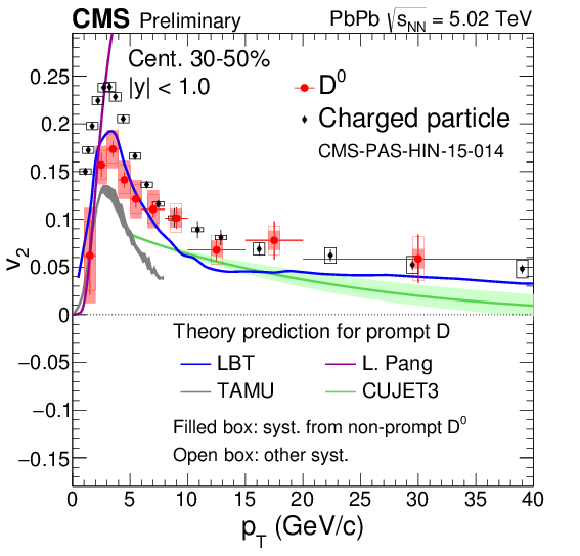
png pdf |
Additional Figure 13-c:
Prompt D0 v2 for centrality 30-50%. Calculations from theoretical models (PRC 94 014909 (2016), PLB 735 (2014) 445, JHEP 1602 (2016) 169 and PRD 91 074027 (2015)) are plotted for comparison. Charged particle v2 in the same centrality class is also plotted for comparison. |

png pdf |
Additional Figure 14:
Prompt D0 v3 for centrality 0-10% (a), 10-30% (b) and 30-50% (c). Calculations from LBT model (PRC 94 014909 (2016)) are plotted for comparison. Charged particle v3 in the same centrality class is also plotted for comparison. |

png pdf |
Additional Figure 14-a:
Prompt D0 v3 for centrality 0-10%. Calculations from LBT model (PRC 94 014909 (2016)) are plotted for comparison. Charged particle v3 in the same centrality class is also plotted for comparison. |

png pdf |
Additional Figure 14-b:
Prompt D0 v3 for centrality 10-30%. Calculations from LBT model (PRC 94 014909 (2016)) are plotted for comparison. Charged particle v3 in the same centrality class is also plotted for comparison. |

png pdf |
Additional Figure 14-c:
Prompt D0 v3 for centrality 30-50%. Calculations from LBT model (PRC 94 014909 (2016)) are plotted for comparison. Charged particle v3 in the same centrality class is also plotted for comparison. |

png pdf |
Additional Figure 15:
Prompt D0 v2 compared with ALICE results (PRC 90 (2014) 034904) for centrality 0-10% (left), 10-30% (middle) and 30-50% (right). |
| References | ||||
| 1 | Y. L. Dokshitzer and D. E. Kharzeev | Heavy quark colorimetry of QCD matter | PLB519 (2001) 199--206 | hep-ph/0106202 |
| 2 | M. Gyulassy, I. Vitev, and X.-N. Wang | High pT Azimuthal Asymmetry in Noncentral A+A at RHIC | PRL 86 (Mar, 2001) 2537--2540 | |
| 3 | E. V. Shuryak | Azimuthal asymmetry at large pt seem to be too large for a pure ``jet quenching'' | PRC 66 (Aug, 2002) 027902 | |
| 4 | CMS Collaboration | Prompt and non-ptompt J/ψRAA with 150 μb−1 integrated PbPb luminosity at √sNN= 2.76 TeV | CDS | |
| 5 | CMS Collaboration | Evidence of b-Jet Quenching in PbPb Collisions at √sNN= 2.76 TeV | Phys.Rev.Lett. 113 (2014), no. 13, 132301 | CMS-HIN-12-003 1312.4198 |
| 6 | CMS Collaboration | Transverse momentum spectra of inclusive b jets in pPb collisions at √sNN= 5.02 TeV | PLB754 (2016) 59--80 | CMS-HIN-14-007 1510.03373 |
| 7 | CMS Collaboration | Study of B meson production in pPb collisions at √(sNN)= 5.02 TeV | CMS-HIN-14-004 1508.06678 |
|
| 8 | ALICE Collaboration | Suppression of high transverse momentum D mesons in central Pb-Pb collisions at √sNN= 2.76 TeV | JHEP 09 (2012) 112 | 1203.2160 |
| 9 | ALICE Collaboration | Centrality dependence of high-pT D meson suppression in Pb-Pb collisions at √sNN= 2.76 TeV | JHEP 11 (2015) 205 | 1506.06604 |
| 10 | ALICE Collaboration | Transverse momentum dependence of D-meson production in Pb-Pb collisions at √sNN= 2.76 TeV | JHEP 03 (2016) 081 | 1509.06888 |
| 11 | CMS Collaboration Collaboration | Nuclear Modification Factor of prompt D0 in PbPb Collisions at √sNN = 2.76 TeV | Technical Report CMS-PAS-HIN-15-005, CERN, Geneva | |
| 12 | ALICE Collaboration | Measurement of prompt D-meson production in p−Pb collisions at √sNN = 5.02 TeV | PRL 113 (2014), no. 23, 232301 | 1405.3452 |
| 13 | CMS Collaboration Collaboration | D0 meson nuclear modification factor in PbPb collisions at √sNN= 5.02 TeV | Technical Report CMS-PAS-HIN-16-001, CERN, Geneva | |
| 14 | CMS Collaboration | The CMS experiment at the CERN LHC | JINST 3 (2008) S08004 | CMS-00-001 |
| 15 | GEANT4 Collaboration | GEANT4---a simulation toolkit | NIM506 (2003) 250 | |
| 16 | Particle Data Group Collaboration | Review of Particle Physics (RPP) | Phys.Rev. D86 (2012) 010001 | |
| 17 | STAR Collaboration | Elliptic flow from two and four particle correlations in Au+Au collisions at √sNN= 130 GeV | Phys.Rev. C66 (2002) 034904 | nucl-ex/0206001 |
| 18 | M. Luzum and J.-Y. Ollitrault | Eliminating experimental bias in anisotropic-flow measurements of high-energy nuclear collisions | Phys.Rev. C87 (2013), no. 4, 044907 | 1209.2323 |
| 19 | E877 Collaboration | Proton and pion production relative to the reaction plane in Au + Au collisions at 11-A-GeV/c | PRC56 (1997) 3254--3264 | nucl-ex/9707002 |
| 20 | M. Cacciari, M. Greco, P. Nason | The pT Spectrum in Heavy-Flavour Hadroproduction | JHEP 007, 9805 (1998) | |
| 21 | CMS Collaboration Collaboration | High-pT track vn harmonics in PbPb collisions at 5.02 TeV | Technical Report CMS-PAS-HIN-15-014, CERN, Geneva | |

|
Compact Muon Solenoid LHC, CERN |

|

|

|

|

|

|